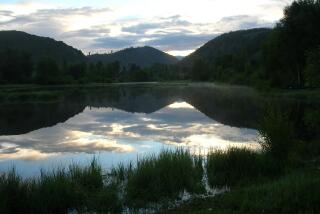The Gold Rush Era Lives Again in the Williamsburg of the West
- Share via
COLUMBIA, Calif. — “You do not squirm, fidget or whine,” admonished the stern teacher. “You must keep clean. There will be a daily inspection of necks, arms and fingernails.”
His grade school students sat on three hard, backless benches in the one-room tent school.
Nearby along the dusty street, at widow Amelia Baker’s mercantile, the storekeeper offered boys and girls hardtack.
Sampling Hardtack
“It’s too hard to chew,” lamented Lacy Siegalkoff, 9, as she chomped away. “That’s why they call it hardtack,” chimed in Cameron Hutsell, 11. Both are fourth-grade students from Reece Elementary School in Lodi.
The youngsters were on a field trip to the opening day of “Columbia Diggins,” an annual four-day re-creation of early gold rush life in this tiny Mother Lode hamlet 70 miles southeast of Sacramento.
Columbia is the Williamsburg of the West. The entire town--homes, shops and public buildings--has been a State Historic Monument since 1954.
“Columbia Diggins,” held on an open meadow just south of town, re-creates the gold camp when it was a tent city before the building of the permanent 19th-Century structures that still stand.
Sherrin Grout, 40, a ranger in the park for 10 years, explained that the tent city is reproduced according to 1850 lithographs of Columbia. One hundred men, women and children of the Columbia Docent Assn. portray people who actually lived in Columbia when the town was founded in 1850.
There were miners panning gold at a sluice, faro games at the local saloon and even upstanding matrons of present-day Columbia and nearby communities depicting women of the camp’s bordellos.
Evelyn Worley, 62, a retired real estate agent, took the part of Emily Barclay, who came to Columbia in 1850 from Maryland and ran the local boarding house--a dollar a night room and board, 25 cents a meal.
Tooth Collection
Dr. Matthew Cummings, 63, a Sonora dentist, portrayed Malcolm McCleod Moore, Columbia’s first tooth extractor. Cummings wore a top hat, vest and gold chain with pocket watch in the style of dentists of bygone days. Next to his century-old red velvet dental chair was a jar filled with alcohol and 150 human teeth.
“The teeth are from my patients,” he explained. “I thought it would make a nice touch. Pulling teeth was about all dentists did in the 1850s.”
All of the living history performers are volunteers who take time out each year from their normal pursuits to relive the experiences of Columbia’s first settlers.
Ralph Hilbert, 67, a retired teacher, delivered the stern instructions to students as he played the role of Robert Porterfield, Columbia’s first teacher.
As the youngsters chewed on hardtack in the mercantile, storekeeper Baker explained how “hardtack was a sustenance that kept us from starving on my seven-month voyage aboard the ship George Emery around the Horn from New York to San Francisco.
“Those were tough times,” sighed the widow, portrayed by Lillian Pantaleoni, 60, who in real life is a retired interior decorator. “My husband contracted scurvy on the ship and died the day after we arrived in California.”
First-grader Emily Peterson, 6, for four days is helping out in the tent laundry, as boys and girls her age did in the gold rush days.
“What are you doing?” Peterson was asked as she stood in an old-fashioned dress, stirring an iron pot. “Doing the laundry,” she said. “We pour starch, bluing and rose petals in this tub of hot water, the rose petals to give the clothes a nice smell.”
Several hundred fourth-grade California history students from schools throughout Central California are being bused on field trips Thursday and today.
Reenactment of the mining camp takes place from 10 a.m. to 5 p.m., through Sunday. About 10,000 people attended last year and park ranger Grout said as many as 15,000 are expected this year.
More to Read
Sign up for Essential California
The most important California stories and recommendations in your inbox every morning.
You may occasionally receive promotional content from the Los Angeles Times.













